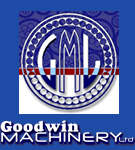| |
B&F Carter Technical Library
A wide range of materials can be produced using Carter
cable and braiding machinery. This requires a full understanding
of the capability of each machine
Technical information currently available:
Click on links below to view PDF files
If you require further technical advice for your Carter
machinery, or would like to see additional information on this page, please contact us.
|
Bobbin |
These contain the material that is to be braided, this
can vary widely and includes steel and copper wire, cotton yarn, and a
wide range of different polymer threads |
|
Capstan Haul-off Wheel |
A large
diameter wheel used with vertical braiders to pull product through
the machine |
|
Carrier |
Individual holder for each bobbin that rotates around the
track |
|
Caterpillar Haul-off |
Pulls the
material through the machine on a horizontal braider using an upper
and lower caterpillar track |
|
Horizontal Braider |
Horizontal configuration braiders are used for larger
production sizes (see also Vertical) |
|
Horn Gear |
A train of gears on a PCD (pitch circle diameter) that
drives the carrier around the track via a slotted plate on top of each
gear |
|
Lay angle |
This is the angle at which the material (wire, yarn etc.)
is applied to the mandrel. The narrower the lay angle, the wider the lay
length |
|
Lay length |
This is the distance between pattern repeats. The
combination of lay angle, lay length and machine speed will determine
the density of the braided material produced. |
|
Maypole |
This is the principle by which all braiding machines
work, similar to the traditional maypole |
|
Multideck |
Multideck braiders are used for more complex materials,
often where braided material is then braided again |
|
Odd numbers
|
Braiders with an odd
number of carriers produce "flat" braid, which is widely used for
catalytic converters -
click here |
|
Picks per inch |
The number of stitches forming the braid
per inch |
|
Supaload©
Carrier |
B&F Carter's high reliability, high productivity bobbin
carrier. Braiding machine speed and output capability are determined by
the number of carriers, which can range from 16 to 96 |
|
Threads per inch |
The number of stitches forming the braid
per inch |
|
Vertical Braider |
Vertical configuration braiders are used for smaller
production sizes (see also Horizontal) |
|
Winder |
Precision winding equipment is essential for the accurate
filling of carrier bobbins to ensure smooth, trouble free production |
We are often asked which type of braiding machine to use
for different sizes of hose. Whilst this will depend to some
extent on the particulars of the hose, we recommend the following:
For 1/2" hose a 24 carrier braider is recommended.
For 1" hose a 24 or 48 carrier braider is recommended.
For 2" hose a 48 or 96 carrier braider is recommended.
Help with PDF files
To get the latest version of Adobe Reader, click on the
link below:

If you have trouble displaying PDF files, check your
Adobe Reader preferences (Edit/Preferences/Internet/R
Display PDF in browser), more help is
available at
http://www.adobe.com/support/products/acrobat.html
Back to Carter Home Page |
Consumables
We have a ready supply of genuine spare
parts available from stock
more...
Troubleshooting
Our trained engineers are available to
help resolve operating problems
more...
Upgrades
Revised control panels can help to
increase productivity and
more... |

